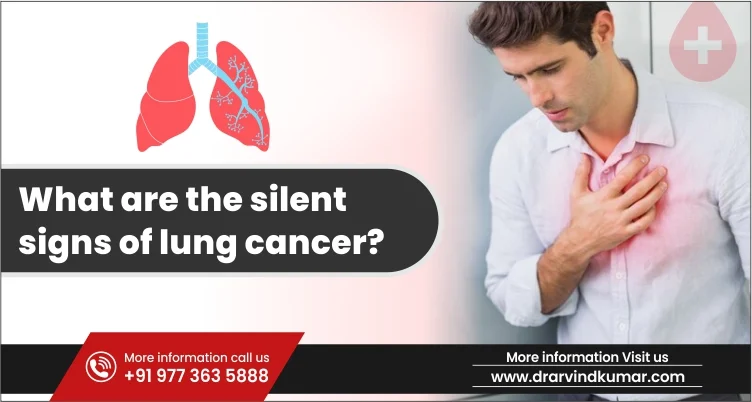Lung cancer is the second-most common type of cancer globally. And that makes you think, right? How are so many people getting diagnosed if they aren’t even aware of the alarming symptoms? That’s primarily because the early signs of lung cancer are not very prominent.
Most lung cancer patients don’t even experience any symptoms until its too late and their cancer has already progressed to a more advanced stage. In the few lucky people who experience the early or silent signs, prioritizing those symptoms is the key.
This article will explore more about the silent lung cancer symptoms, what they entail and what you can do for an early diagnosis and treatment.
What are some of the Expected or Common Symptoms of Lung Cancer?
Before we further explore the silent signs of lung cancer, let us walk you through the most common ones we witness in patients at Medanta.
Remember that lung cancer symptoms can be subjective experience. While some patients experience one or no symptoms, some might experience a mixture or all of the following mentioned symptoms.
- Persistent coughing that doesn’t go away despite treatment or medications
- Experiencing shortness of breath or feeling a constant tightness in and around the chest region
- Coughing up blood alongside mucus and phlegm
- Experiencing sharp shooting pain in the chest, especially while breathing or coughing
- Experiencing wheezing when exhaling air out of the mouth
These are some of the most common symptoms associated with lung cancer. If you are experiencing any or multiple of these signs and they aren’t settling or recovering on their own, Dr. Arvind Kumar and our team of specialists emphasize prioritizing those symptoms and getting medical advice as soon as possible.
What are the Silent Signs of Lung Cancer?
Knowing about the silent symptoms of lung cancer can make a huge breakthrough in your diagnosis. Much like how you experience pain in the left arm before a heart attack, there are several unexpected and silent symptoms of lung cancer that most people don’t have the slightest hint about.
Knowing about the following is crucial for early lung cancer detection and proper lung cancer treatment in india.
1. Pain in the Arm or Shoulder
Patients affected with Pancoast lung cancer often experience pain in the upper arm and shoulder region. In this type of cancer, the tumor forms in the upper part of the lungs, settling or further metastasizing into the ribs and the vertebrae.
In some cases, the tumor compromises the blood supply and neural conduction, leading to pain in the arm and shoulders. Some patients even report constant numbness and tingling in the arms and extremities.
2. Eye Problems
Another sign of Pancoast lung cancer that no one pays attention to is eye-related complications. Signs like changing the size of the pupils, drooping eyelids, even less sweating, etc., are shocking and silent signs of developing lung cancer inside.
These silent symptoms are collectively termed the Horner Syndrome and are very common in patients suffering from non-small cell lung cancer (NSCLC).
3. Fluctuating Weight
Another underrated and unexpected sign of lung cancer that many patients overlook is their weight. Lung cancer patients experience sudden fluctuations in their weight, which means, it may either increase or decrease rather starkly.
The situation can go two ways:
- Some lung cancer patients with small cell lung cancer (SCLC) produce a hormone called Adrenocorticotropic hormone (ACTH), which elevates the cortisol levels in the body. High and uncontrolled cortisol leads to weight gain.
- On the other hand, other lung cancer patients may have poor appetite and weight loss.
Either way, noticing a sudden change in body weight is necessary if you are at risk of developing lung cancer.
5. Bone Pain
When you go for a lung cancer diagnostic test, be aware that the doctor will enquire about your bone health. Although a silent symptom, bone pain is a leading red alert that you could have lung cancer developing within.
If you are feeling discomfort, pain, and even inflammation in the bones and joints, it could be a sign of lung cancer. Patients whose lung cancer has metastasized to the bones often experience the symptoms of bone pain and discomfort.
6. Changes to the Voice
Again, when talking about silent or unexpected symptoms, this one deserves a special mention in the list.
If you notice a sudden change to your voice, especially with heightened hoarseness, it could indicate a potential risk of lung cancer. This sudden change could be due to the growing tumor pressing down on the vocal cords, changing the intensity of the voice or the way you sound.
7. Feeling Parched
Now, this is a symptom that many associate with diabetes. Feeling too thirsty all of a sudden? Maybe, you have diabetes. Need to use the washroom? Maybe, you have diabetes.
However, what not many of us realize is that extreme levels of thirst and frequent urination are also silent symptoms of lung cancer.
Some lung patients may have elevated levels of calcium in the blood, which can contribute to these symptoms.
8. Persistent Headaches
Be it for lung cancer or any other chronic disease; headaches are potentially one of the most recurring symptoms that we push to the curbside. However, what you fail to realize is that headaches are an alarming sign of several diseases, including lung cancer.
Much like balance, the pooled-up blood in the SVC also leads to a throbbing and persistent pain in the head. So, if a lung cancer tumor is obstructing the Superior Vena Cava, it could lead to headaches. Headache may also be a sign of speedy spread of Lung Cancer to the brain.
Besides the blood pooling, the headache is also a direct consequence of hypercalcemia or elevated calcium levels in the blood, which is a leading cause of lung cancer.
9. Chronic Tiredness
Most lung cancer patients show signs of anemia, leading to poor oxygenation of the blood and an affected level of energy in the body.
If you are feeling tired despite getting a good night’s sleep or after a nap, it could indicate that something isn’t right physiologically. Remember that chronic fatigue doesn’t necessarily mean you have lung cancer, but it could be a potential sign that many push to the side.
10. Cardiovascular Complications
If you are diagnosed with arrhythmia or tachycardia and don’t have a proper understanding of the “WHY,” it could be a consequence of lung cancer.
The growing tumor due to lung cancer often leads to potential complications of high calcium levels and anemia in the patient, both of which are key triggers in developing heart complications. Persistent hypercalcemia also elevates the risks of a heart attack; hence an early diagnosis and management are essential.
If you are experiencing symptoms like chest pain, shortness of breath, or a persistent cough, these could indicate heart complications led by lung cancer. What Are The 7 Signs Of Lung cancer?
What are the Symptoms of Advanced Lung Cancer?
Lung cancer is a progressive disease that often goes undetected. Getting a diagnostic evaluation of lung cancer involves closely assessing the symptoms.
Some of the common signs of advanced stages of lung cancer are:
- Bone pain
- Headaches
- Dizziness
- Swelling in the face
- Jaundice
- Weakness or numbness in the limbs
- Lumps in the collarbone or neck
- Coughing up blood
- Recurrent chest or lung infections, etc.
As the tumor grows and spreads, the symptoms are bound to get worse over time. Hence, paying close attention to even the slightest change in the body’s physiology is crucial.
When to See a Doctor?
Lung cancer imposes various neurological, paraneoplastic, and metastatic symptoms.
Irrespective of which stage your lung cancer has progressed to, seeing a doctor depends on the symptoms you are experiencing.
If you notice a slight cough that’s persistent and doesn’t recover over time, it is a sign that could indicate a potential risk of lung cancer. The earlier you get it checked, the easier it is to get a potential early lung cancer diagnosis and treatment.
As Dr. Arvind Kumar suggests, if you are experiencing persistent symptoms, consult a doctor, get a chest X-ray, and if you or your doctor have further suspicions, you can opt for a CT scan.
Conclusion
Lung Cancer is a deadly disease. The only thing that has shown improved survival is early diagnosis. Unfortunately, many patients have minimal to no symptoms in the early stages. Nevertheless, some symptoms like persistent cough, unexplained weight loss, shortness of breath, chest pain can be due to Lung Cancer. Also, any other symptom that is persisting, requires evaluation by an expert to rule out any serious underlying illness. Do not ignore any persistent or recurrent symptoms and seek medical advice as soon as possible.
For more details on that, visit https://drarvindkumar.com/contact-us.php.
FAQs
How can I check myself for lung cancer?
The best way to check yourself for lung cancer is to pay close attention to any recurrent or persistent symptoms like coughing, shortness of breath, dizziness, fatigue, etc.
How long can you go without knowing you have lung cancer?
Lung cancer often goes undetected in the earlier stages since it seldom produces any symptoms. Some patients can go for years and a decade before they start noticing debilitating symptoms.
Where do you feel lung cancer pain?
Chest pain is often attributed to the lung cancer pain that most patients complain about. Besides that, patients with Pancoast tumors also complain of pain in the arms and shoulder.

.webp)



